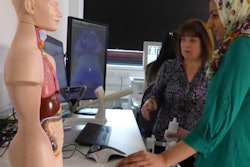
When radiologists are unavailable to provide final reports in a timely fashion, sonographers are capable of providing interpretations of abdominal ultrasound studies in an emergency setting, according to Australian research published online in Radiography.
In a retrospective review of 86 emergency abdominal ultrasound studies, a team led by Michal Schneider, PhD, of Monash University in Victoria found that sonographers' findings had total agreement with radiologists' reports in 85% of cases. No cases were reported of major discrepancies likely to result in significant adverse patient outcomes.
"Sonographers, without any formal training in producing the final diagnostic report, have the ability to address the clinical questions posed by ED physicians with regard to abdominal ultrasound," Schneider told AuntMinnie.com. "In terms of hedging vocabulary, caveats regarding image quality, and requests for further investigation, sonographers in Australia can match the performance of radiologists in these cases."
In Australia, sonographers have traditionally performed diagnostic medical ultrasound exams, generating recorded images and written sonographer findings. These are then used by radiologists to provide the diagnostic outcome of an ultrasound examination in the form of a written report, Schneider said.
At Toowoomba Base public regional hospital in Queensland, Australia, however, sonographers provide the final diagnostic report with little or no radiologist involvement due to the limited number of radiologists working at the hospital, she said. Anecdotal reports from one of the study co-authors (who trained at Toowoomba Base Hospital and is now working at the Townsville Hospital in Queensland), as well as the Australian Sonographers Association work practices survey in 2009, have led to the discovery that this practice is not uncommon within regional and remote Queensland.
Informal role extension
While this suggests there has been an informal role extension for sonographers in Queensland, the efficacy of using sonographers to provide the final diagnostic report had not been tested before in Australia, she said.
As a result, the researchers sought to compare sonographer findings with radiologist reports in abdominal ultrasound cases referred by the emergency department at a large regional tertiary hospital (Townsville Hospital). They initially identified 183 abdominal ultrasound exams for consideration, but of these, 61 (33.3%) were not reported by a radiologist. In 24 cases (13.1%), the radiologist and sonographer collaborated on the final report, and an additional 12 cases (6.6%) were reported by a radiology registrar (Radiography, November 14, 2013).
The remaining 86 cases were used in the study; they were performed by one of 11 sonographers with experience ranging from six months to 21 years. Nineteen cases (21.8%) were reported to be within normal limits by both the sonographer and radiologist.
A consultant intensivist scored all exams into one of four categories of diagnostic agreement between sonographers and the radiologists who provided the final report. The intensivist, who was not affiliated with the emergency or diagnostic imaging departments, also assessed whether hedging terminology was used and whether the clinical question was answered. The same rater also noted when further requests were made for investigations, including imaging.
Diagnostic agreement was as follows:
- Category 1: Sonographer findings agreed with the radiologist report: 73/86 (84.9%)
- Category 2: Minor discrepancy unlikely to alter patient management: 12/86 (14%)
- Category 3: Moderate discrepancy likely to alter patient management but not lead to adverse outcome for the patient: 1/86 (1.1%)
- Category 4: Major discrepancy, with sonographer findings likely to result in a significantly adverse outcome for the patient: none
No significant differences were found in terms of hedging, ability to answer the clinical question, requests for further investigations, or interpretation of image quality, according to the researchers.
In other notable results, Schneider pointed to the 61 cases from the original research dataset that only had sonographers' findings, suggesting that no radiologist reports were generated for those cases.
"It appears that the clinical decision-making in those cases was reliant entirely upon the sonographers' findings and that informal role extension by sonographers has already taken place at the Townsville Hospital due to the radiologists not being able to get through the daily reporting work," she said.
Accurate and cost-effective
With the scarcity of public health resources and increasing demands for medical imaging and radiologists' time, sonographer findings can provide accurate, timely, and cost-effective diagnostic results that can be used by treating medical practitioners to guide treatment, at least for some examination types, Schneider said.
"Role extension by sonographers is not about replacing radiologists, but rather working in collaboration with them to provide both improved service delivery and patient outcomes in circumstances when radiologists are not available to interpret ultrasound images in a timely fashion," she said.


















